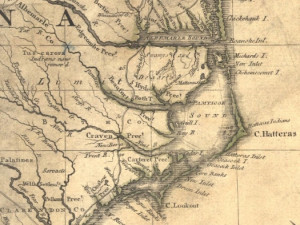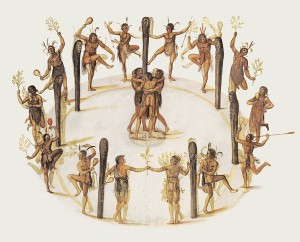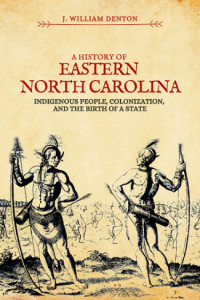William Denton discusses a major source of the culture clash between Algonquian people and the first Europeans in North Carolina.
###
 Relevant History welcomes William Denton: historian, author, and blogger. Born and raised in Eastern North Carolina, his areas of study include ancient and classical history, North Carolina history, education, and politics. William attended North Carolina State University, Liberty University, and Unicaf University, holds a BS in Religion, an MA in History, and a Ph.D. in Humanities. He is a member of the American Historical Association and the Association of Ancient Historians. His historical nonfiction, A History of Eastern North Carolina: Indigenous People, Colonization, and the Birth of a State, will be released next week on 28 October. William and his wife live in Nash County, North Carolina with their son. To learn more about him and his books, visit his web site.
Relevant History welcomes William Denton: historian, author, and blogger. Born and raised in Eastern North Carolina, his areas of study include ancient and classical history, North Carolina history, education, and politics. William attended North Carolina State University, Liberty University, and Unicaf University, holds a BS in Religion, an MA in History, and a Ph.D. in Humanities. He is a member of the American Historical Association and the Association of Ancient Historians. His historical nonfiction, A History of Eastern North Carolina: Indigenous People, Colonization, and the Birth of a State, will be released next week on 28 October. William and his wife live in Nash County, North Carolina with their son. To learn more about him and his books, visit his web site.
*****
 The coast of Eastern North Carolina was once home to an abundance of Algonquian tribes. The Iroquoian Tuscarora tribes were more influential within the Upper and Lower Inner Banks and Coastal Plain regions. These various Algonquian-speaking peoples occasionally formed loose affiliations and alliances, which, when paired with their overlapping cultural practices, sometimes blurred the lines of individual tribal identification.
The coast of Eastern North Carolina was once home to an abundance of Algonquian tribes. The Iroquoian Tuscarora tribes were more influential within the Upper and Lower Inner Banks and Coastal Plain regions. These various Algonquian-speaking peoples occasionally formed loose affiliations and alliances, which, when paired with their overlapping cultural practices, sometimes blurred the lines of individual tribal identification.
For example, the historical mentions of the Weapemeoc Nation can lead to some confusion, as the nation consisted of an association of subdivided tribes named the Pasquotank, Perquimans, and Poteskeet. The Weapemeoc were also often referred to as the Yeopim Indians, presumably from the English’s difficulty in pronouncing the tribe’s Algonquian name.
As English incursions into native territory increased, social disruptions created various cultural shifts within the local tribes, further complicating the issue of identity. One of the most interesting aspects of Algonquian culture, however, has to do with the role that women played in the political and social structure of the tribes.
The role of women in Algonquian villages
The Algonquian nations of Eastern North Carolina possessed a beautiful and well-preserved culture that differed from that of the Europeans in key aspects. Some native tribes in the area were matrilineal, meaning that familial relationships and organization were centered around the mother, as compared to the Western patrilineal culture wherein family lineage was reckoned along the father’s ancestral line.
One of the best examples of this is the case of Manteo’s mother, who was said to be a leader within Croatoan society before being inadvertently killed by English colonists during a confusing conflict between the Croatoan and Roanoke tribes.
Even in tribes without strict matrilineal practices, women wielded considerable power and influence within the native Carolina populations. In the family unit, individual homes were owned by women, with a man marrying into a woman’s home and joining her family. Clan names were often passed down through the mother, as opposed to the Western tradition of paternal surnames.
The matrilineal customs of the native peoples perplexed the European colonists, as they frequently attempted to deal with only the male members of tribes in matters of trade and diplomacy. Sometimes this confusion over internal tribal power structures led to treaties and land agreements being delayed or misunderstood as the English insisted on dealing only with the men from native settlements, even though some tribal leaders were female.
It would be inaccurate, however, to label these native tribes of Eastern North Carolina as matriarchal. Though influence often passed along maternal lines, men also exercised political influence and tribal control. Hunting and fishing rights passed from father to son, and many tribes recognized a paternal line of authority within their village.
The founding of many villages centered around a common male ancestor. Shamans were almost always men and had considerable influence over chiefs and elders. If anything, the native populations had relatively balanced gender roles, especially when compared to the European society of the time.
The village homes were owned by women who helped manage affairs within the village, including cultivating crops and gathering resources. Men hunted and protected the settlement. Both men and women contributed to governing their villages.
The communal nature of indigenous political organization
In matters of politics, the native tribes were characterized by communal leadership rather than a formal system of government. While chiefs led local villages within a tribe, the majority of decisions were made by mutual consent of a council of some sort, usually made up of elders and well-respected members of the tribe, though decisions were made in the best interests of the entire village.
 While the exact power structure varied from tribe-to-tribe, all Algonquian tribes shared common elements and traits. For example, unlike their Iroquoian counterparts, the Algonquians did not form strong alliances or political bonds with other Algonquian tribes, though they did collectively respond to military threats at times. The Algonquians were more interested in village-based relationships, with many clans who claimed a common ancestry gathering together in a local settlement.
While the exact power structure varied from tribe-to-tribe, all Algonquian tribes shared common elements and traits. For example, unlike their Iroquoian counterparts, the Algonquians did not form strong alliances or political bonds with other Algonquian tribes, though they did collectively respond to military threats at times. The Algonquians were more interested in village-based relationships, with many clans who claimed a common ancestry gathering together in a local settlement.
The Algonquian tribes of Eastern North Carolina held time-honored customs and beliefs that predated the arrival of Europeans by centuries, if not millennia. As the English colonists began to expand into Native territory and establish trade relationships with the various tribes, the native populations began to suffer irreparable harm.
Disease, warfare, slavery, land theft, and the disruptive nature of the colonists’ technological advancements quickly reduced the Carolina Natives’ populations within a century of initial contact with the Europeans. Their cultures were also forever changed, with many tribes assimilating into the newly encountered European way of life and disappearing from the pages of history. The important role that women played in the social structure of the Algonquian people, however, is one historical element that must not be forgotten.
*****
 A big thanks to William Denton! He’ll give away a copy of A History of Eastern North Carolina to someone who contributes a comment on my blog this week. I’ll choose the winner from among those who comment by Friday at 6 p.m. ET. Delivery is available within the U.S. only.
A big thanks to William Denton! He’ll give away a copy of A History of Eastern North Carolina to someone who contributes a comment on my blog this week. I’ll choose the winner from among those who comment by Friday at 6 p.m. ET. Delivery is available within the U.S. only.
**********
Did you like what you read? Learn about downloads, discounts, and special offers from Relevant History authors and Suzanne Adair. Join Suzanne Adair’s Patreon, and subscribe to her free newsletter.
